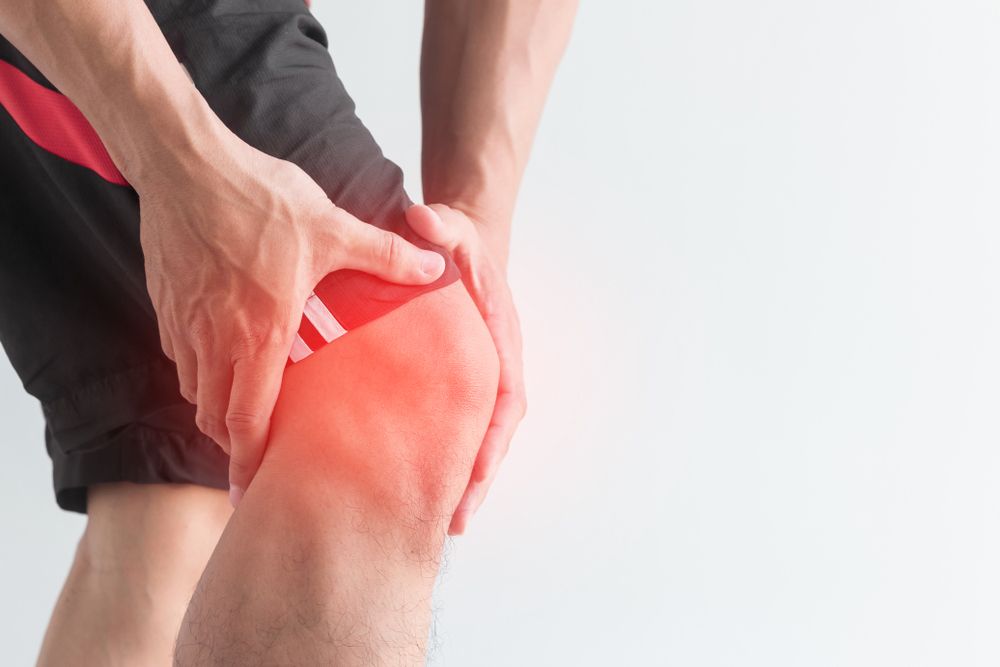To relieve knee pain and body aches begin with your feet. When I say this to people, they look at me like I have lost my mind. However, if you study the human body from a balancing perspective, what you’ll see is the importance of the feet and how we, as a society, have mistreated them. We tend to think of pain as a problem in the area where we feel it and we, and health care professionals, only treat that area. In all my experience with the human body and muscles, rarely have I seen that the source of the pain comes from the painful place itself.
When we feel foot pain like arch soreness, heel soreness, or the ball of the foot being sore, we think of only the foot and not how to relieve knee pain. We go to the store, maybe get on one of those machines for your feet, then decide to buy an insert or pad to stop that pain. The funny thing about those machines is that people use them to see how they are walking. Do they walk on the outside or inside of the foot? Do they place more pressure on one side of the heel or the ball of their foot? You do not need a machine to tell you that. Just look at the bottom of an old pair of shoes. Look at how they have worn, and you can clearly see how you walk.
This is just the beginning of the story
If you are suffering from knee pain and you walk on the inside or outside of your feet, every step you take places increased pressure on one side or the other of the knee, depending on how you walk. This can also affect the hips, back, and neck. If you are pushing off from the outside of the foot, you are adding additional pressure to the outside of the knee which can lead to shin splints and increased knee pain, in the beginning, damage to the cartilage later, and even issues with hips even later than that.
If you walk on the inside of the foot, now you are placing pressure on the inside of the knee causing the inner thighs to shorten, which will tilt the pelvis forward, which can lead to low back pain in the middle of your back. Whew! That is a lot to cover in a short space.
If you walk on the outside of your heels, the foot is slightly rotated outward, which is coming from the rotation of the hip joint. Most people who walk with their foot rotated slightly outward will usually suffer from bunions, calluses on the inside of the big toe, and in some cases, Morton’s Neuromas. The reason is that rotating the foot outward forces you to push off from the inside of the big toe which will cause a callus. Later, that callus becomes a bunion, and, over time, it will pinch the rest of your toes, leading to a neuroma. Keep in mind, the rotation outward places unnecessary pressure on the knee and hip as they are rotated too.
Some people walk on their toes, or the ball of their feet, which can tighten the calves, leading to Achilles’ tendonitis or plantar fasciitis. The ball of the foot, which can be considered the knuckles of the toes, can become sore. If you are a heel striker, then the heel becomes sore. Of course, there are pads for these designed to stop the pain, but not the source of the pain.
Finally, the shoes we choose to wear will determine just how far our ankles will bend. The less the ankle bends, the more the upper thigh must work for us to walk. This can lead to back pain on either side of the back or, surprisingly, upper back and neck pain. You heard me right. The less your ankle bends, the more you need to move your head forward to walk.
My Stretch ‘n’ Release Technique is perfect for helping you solve these issues and getting back to doing the things you enjoy. I would suggest you spend 15-20 minutes each morning and evening doing this technique so you can work and play as much as you want without paying the hefty price of pain.
How Does Knee Pain Happen?
Our feet are comprised of 29 muscles, 26 bones, and 33 articulations, meaning your feet need to bend in the middle so the ankle can bend up to 110 degrees. When we wear shoes that are stiff with thick soles, arch supports, heel supports and pads under the bottom of our feet, we limit the range of motion of the ankle, causing the muscles in the foot to atrophy. Wearing thick-soled shoes prevents the 272 nerve endings on the bottom of our feet from sending messages to our brain regarding the changes in gradation of the ground. This could lead to a fall.
When the muscles of the foot atrophy, walking on a hard surface feels impossible. I know you may have been told by a healthcare professional to never walk barefoot on a hard surface. Their purpose is to stop your pain and I get it. The shoes do stop the pain, but the shoes may cause pains in other areas of your body.
Next time you are out and about, sit and watch a few people walk by. Look at their feet and see how little their feet bend, then look up and see if they are leading with their nose instead of their belly button. It may take a little practice, but you can see it. If you know them, ask them how their back or neck feels and you most likely will hear how much pain they are in.
When the range of motion of the ankle is limited, it forces the body to walk using the front of the thighs. As the front of the thighs begins to tighten from overuse, these muscles can pull the pelvis forward. When the pelvis is pulled forward, it increases the compression on the low back as it pulls the torso forward. As the torso leans forward so does the head. Keep in mind that every inch your head leans forward, pressure on the back of the neck increases by 10 pounds. Ouch! That can be very painful and who knew it was coming from your feet?!
Want to Relieve Knee Pain?
Stand barefoot, or in your socks, and walk, focusing on what you feel on the bottom of your foot. Take your time and notice what part of the foot you are hitting first. Is it the heel, the ball of your foot, or the inside/outside of the foot? If you’re worried about losing your balance, I would suggest doing this next to a wall so you can catch yourself.
If you find yourself becoming wobbly, you may need to strengthen your feet and/or calves. To strengthen your feet and calves, stand barefoot next to a counter in the kitchen. As you are holding onto the counter with your hands, lift one foot off the ground an inch or two. Notice the muscles firing in your feet and calves. Slowly lift your hands off the counter by no more than an inch, then count how long you can stand there on one foot without holding the counter. Don’t worry if you can only do it for a few seconds. Practice each day and you will see the length of time increase.
I did this exercise at the University of South Florida with students, ages 18-22. Half of the students could only hold it for 8-10 seconds before needing to place the other foot back on the ground, which showed me it was not an age thing, but a weakness thing.
I have worked with many young athletes with tight calves and feet from their workouts. The funny thing is, they move no better than the older people and deal with similar aches and pains. Most hamstring injuries and back injuries stem from the feet and calves.
As we get older, falling becomes a major worry. For most older people they will simply walk with shorter strides. Unfortunately, this may lead to shoulders being hunched over and neck pain. The last thing we all want is to look older than we are, right? Improving your confidence in your balance can help you increase your stride and reduce the fear of falling.
Learning to Walk at Any Age
Many of us never give walking a second thought and few healthcare professionals ever talk about walking correctly. For many of us, the last time someone talked to us about walking we were probably 2 or 3 years old. So, what we know about walking is what we learned as a toddler. Ever seen someone walking like a toddler? Walking takes practice. Again, if you feel uncomfortable, practice next to a wall for support.
If you use a walker or walking cane, keep it with you but only use it to steady yourself. I see too many people leaning over and pushing their walker like they are pushing a boulder down the street. When using a walker, stand up straight, let the handles be by your side as you walk upright. The walker is a supplement to walking. Unfortunately, too many people with walkers suffer from back and knee pain and cannot stand up straight due to the front of their thighs being too tight and adding too much compression to their low back. Below I have added the quad stretch and an ankle stretch to help with that.
If you use a walking cane, use it as a supplement and do not lean on the cane as you walk. Leaning on the cane will cause the muscle, Tensor Fascia Latta, to spasm. These muscles are on both sides of your hips and can cause the pelvis to tilt sideways, again causing increased back compression. Practice walking standing up straight and only use the cane to steady yourself.
Learning to walk properly can relieve many of the common aches and pains, especially relieve knee pain, that so many people suffer with, sometimes for years. The softer your feet and calves, and the more flexible they are, the better balance you will have which leads to better confidence when you walk. Isn’t that what we all want?
Stretching is more about feeling the muscles letting go than forcing them to stretch. If you are forcing the muscle, you could be doing strength training, not stretching. Make sure you are feeling the intended muscle stretching. If not, the form could be wrong. Holding for 5 seconds allows the brain to release the muscle before it senses any danger. Repeating the stretches 10 times allows the brain to learn it is safe for the muscle to move that way.
Video: Foot Pronation and Supination
Don’t Forget the Tennis Ball Massage!
Softening your hips and back is easy when you use the tennis ball. Just lean against the wall and apply enough pressure to feel the painful area. The temptation is to press harder but resist it. Instead, breathe out and allow the muscle to soften under the ball. Then move to another spot and repeat. Continue doing this until most of the painful spots are gone. Check out previous newsletters to see the video.
If you like this newsletter, please share with your friends and family. Don’t forget to check out our social media pages, leave a comment, and as always, reviews are awesome!


